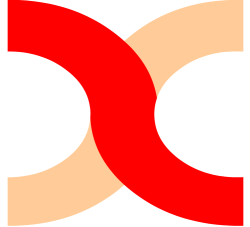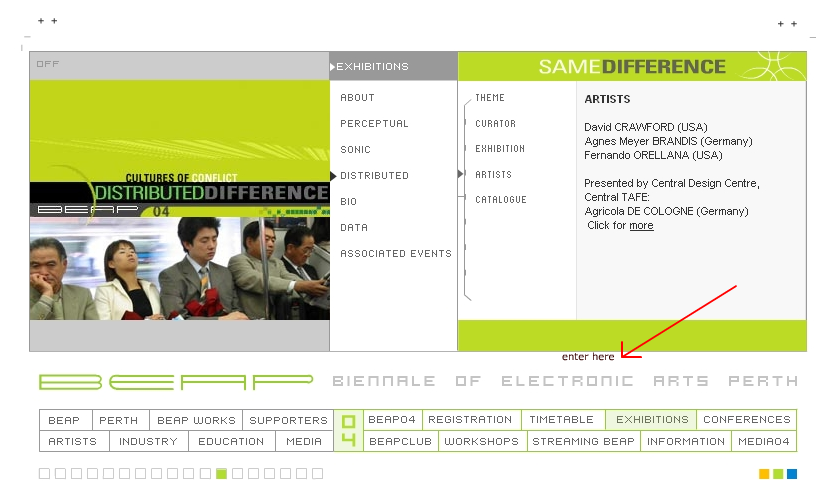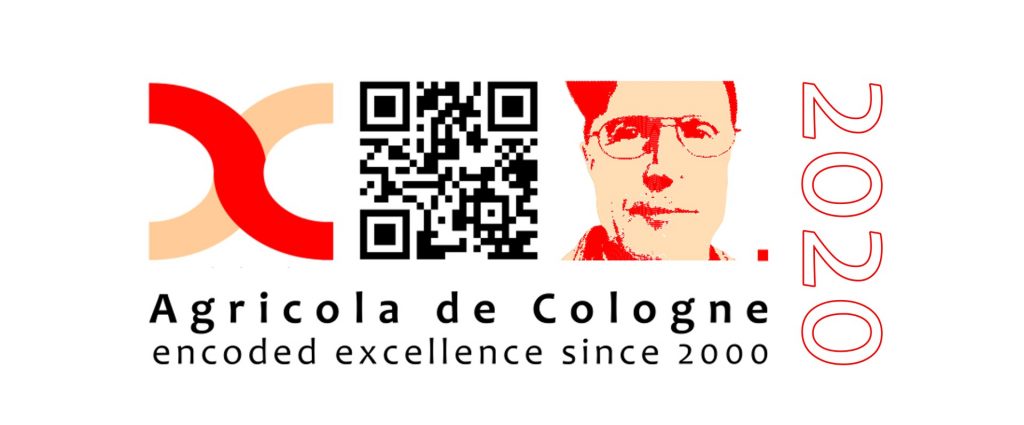Agricola de Cologne – encoded excellence in art
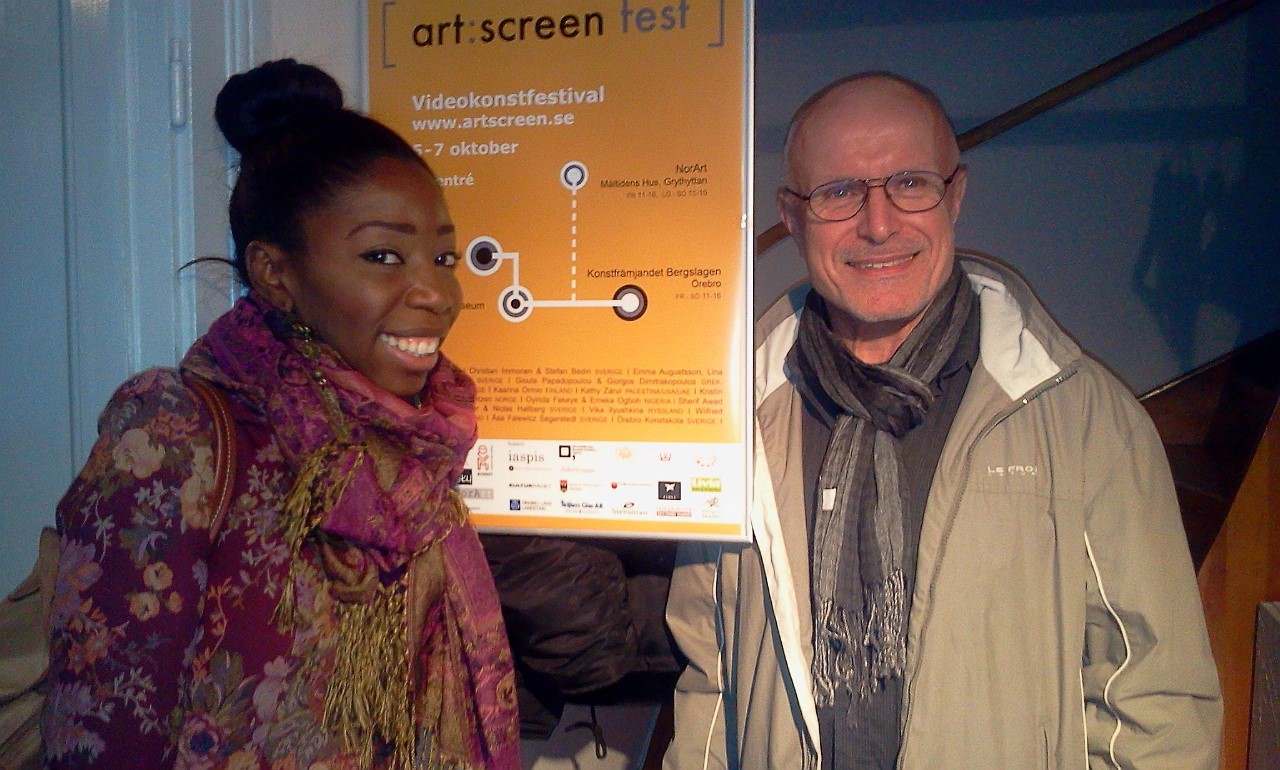
static, moving & interactive images – Internet based art, videoart, photography, sonic art-
focussed on the topics „memory“ & „identity“
Agricola de Cologne
has lived and worked as a freelance artist in Cologne since 1981, and since 2000 he has worked exclusively with new media as an artist and curator. In 2010 he developed NewMediaArtProjectNetwork://cologne, which was launched in 2000, into The New Museum of Networked Art – a new type of museum that – dedicated to an international artist community that has been developing since 2000 – realizes a variety of projects in the field of digital art with static, interactive and moving images, as well as non-visual art forms (sound art) in exchange between self-created, virtual and physical spaces of international cooperation partners such as museums, public galleries and festivals.
The main contexts of his experimental artistic/curatorial activities are/were JavaMuseum (for internet-based art) 2000–2010, SoundLAB – sound art projects 2004–2024, CologneOFF/New Institute for Contemporary Art with international video art festival 2005–2024 and The 7 Memorials for Humanity 2001–2024.
In addition to curating as an independent art form tailored to his personality, Agricola de Cologne is involved in his own audio-visual and intermedial art projects.
He has directed/curated Alphabet Art Centre @ The New Museum of Networked Art since its founding in 2020 – a forum for temporary exhibitions of art with moving images and non-visual forms of expression.
The New Museum of Networked Art (2000 – )
artvideoKOELN (2005 – )
CologneOFF – International Festival Network (2005 – )
A Virtual Memorial Foundation (2000- ) – including the major projects
– Violence Online Festival (2003-2006)
– [R][R][F] Project (2003-2006)
– AVMCI – A Virtual Memorial Commemorative Interventions (2011-2014)
– The W:OW Project (2017)
– The 7 Memorials for Humanity (2018)
JavaMuseum – Forum for Internet Technology in Contemporary Art (2000-2010)
– 1st virtual museum for virtual art
VideoChannel – curatorial platform for art & moving images (2003-2012)
SoundLAB – sonic art projects (2003-2010)
Chief curator of
Audiovisual Art Collections @ The New Museum of Networked Art
include about 8000 art films & videos
– VideoChannel Collections including 60 curators from 40 countries
– CologneOFF Collections – 10 festival editions – 2005-2014
– artvideoKOELN Collections
– Collective Trauma Film Collections
– featuring Refugee Film Collection, SFC – Shoah Film Collection, Cambodia 1975-1979,
No More! Hiroshima-Fukushima

For Agricola de Cologne, curating, as well as networking forming the basis for curating, is representing his specific kind of art expression, it is virtual and physical art alike. Curating is no “job” and does not represent an institutional task based on scientific research, but an artistic action based on the need to approach art from a different point of view, but like doing any other kind of art, exclusively from his very personal point of view.
In fact, he started curating in 1990. Although he was following courses of art history during his university studies in Munich (1971-1974), he had, however, no education in curating, courses in curating did not exist, yet. He did it, like anything else, by doing, because the given situation required from him to curate. In this sense, he did it rather like a museum curator without the ambition to do an artistic action via curating.
Agricola de Cologne’s curatorial activities can be divided in two parts 1990-1994 and 2000-
In 1989, he started the Project “German Re-unification” on 9 November 1989 by founding ARCHA Society Foundation (ARCHA e.V. – Archives and Research for Contemporary Humanism and Art), which he was running as its President and curator until 1994.
He organised and curated three major projects for ARCHA Society
Patronage The Prime Minister of the Free State of Saxony – Prof. Dr. Kurt Biendenkopf
Starting in 2000 his third life from point zero, dedicated to the new artistic (electronic) media, using the Internet as an artistic medium was automatically enforcing curating as a primary activity. Agricola de Cologne was combining all kinds of responsibility in one person, the programmer, the designer, the director, the artist, the curator, the public relations manager, thus the entire staff of a production company or museum etc. This aspect that everything Agricola de Cologne was doing since 2000, was exclusively the work of one single person, whereby his project, as typically Internet specific works, were, differently from usual art works, ongoing after their initialization, so the creator was always running different projects and platforms, at the same time, influencing each other progressively.
When Agricola de Cologne initiated himself as a brand and virtual artist, he had no idea about the consequences. In one way, he actually wanted to continue his ideas of an artistic commemoration on a virtual level in Internet, which had started in physical space some years years ago. On 1 January 2000, he released as his first artistic manifestation on the net ” A Virtual Memorial”, the counter part to his physical project “A Living Memorial” (1995-1998), but expanded to a global level adressed to the online audience on all parts of globe. He started a kind of diary posting at first daily, later weekly and monthly his reflections about incidents global-wide which he was thinking to be worth to be commemorated by creating smaller Internet based interactive works. He initiated his first calls for artists participations, not being aware that he was starting curating by inviting the first artist to participate and contribute.
Projects like “JavaMuseum – Forum for Internet Technology in Contemporary Art, A Virtual Memorial or The New Museum of Networked Art give evidence of the ambition to simulate in Internet such established cultural structures by doing it in an Internet specific way via partcipatory and networking aspects, by including curators, artists and cultural institutions. Curating was not restricted to take responsibility for a physical art collection or an exhibition, but the contents, the artists, the curators, artworks, networking partners – institutions or organisations and not to forget, the virtual and physical space.
By realising his projects by inviting artists, curators and institutions he was continuously creating and generating virtual and physical artworks visually and sensually perceivable by the users. Via the interactivity of these projects, the users became curators, as well. In this sense, curating means for Agricola de Cologne also basically activating the user or viewer and eliminate the passive consumer position.
Although the curatorial activities during the first phase (1990-1994) had retrospectively seen, also highly interactive components by encouraging the audience and enforcing dialogue on different levels, they were nevertheless quite conventional compared with that kind of curating which the Internet was generating, enabling and enforcing, and Agricola de Cologne did that kind of curating not define, yet, as an art creating of itown, which he became aware only later. So, curating became part of his artistic concepts born from the necessity the Internet as a medium of art was generating.
One has to consider, when Agricola de Cologne started in 2000, only short time before, the Internet had become only popular, the computer was not recognized, yet, as a serious art tool, and the established cultural structures like art museums, were generally refusing the computer, the Internet and new technologies and the artists using these tools.. The Internet connection was at the lowest speed of 28 Kb-56 Kb, streaming video was still an utopia, nevertheless, Agricola de Cologne recognized immediately the relevance of streaming video, and generated from his own digital video sources a kind of low-tech streaming video by programming, which however became obsolete when the technology became more advanced some years later.
Of course, Agricola de Cologne was not the only artist or cultural activist, who was dealing with the virtual art works in virtual space, nevertheless projects like “JavaMuseum – Forum for Internet Technology in Contemporary Art” were pioneers in many concerns, as a new cultural structure such a project was curated in any concern, by designing a museum acting in virtual space for virtual art, designing interfaces and curating virtual space, developing the projetcs (departments) incorporating Internet based art works by active artists, keeping close contacts to the artists and encouraging them to continue, creating and maintaining networks. Until 2005, he curated in total 18 projects/exhibitions for JavaMuseum to be followed by two big shows in 2007 and 2010 . All of them are still running online, but were many times installed on monitors as a part of physical exhibitions. As a designer of culture, Agricola de Cologne got many privileges because he was dealing with the artists directly and it was obvious that the project of the museum or platform was representing an art project itself.
In 2003, Agricola launched on the day when the Iraq War began, his project “Violence Online Festival”, a curatorial challenge running until 2005. The global-wide effects of the manifestations of violence were representing an occasion to deal with violence and war, but the real cause was, of course, to reflect the own affection of violence via the art works by other artists and curating.
A particular mark is representing the year 2004 for Internet based art, it was a high time and cumulation point before its decline, and 2004 was for Agricola de Cologne a changing point, as well, because invited by Biennale of Electronic Art in Perth (Australia) he created the global networking project [R][R][F]200x—>XP – featuring different plafforms for different digital art media like VideoChannel – video project environments and SoundLAB – sonic art project environments.
While he realizsed in the context of SoundLAB until 2010 annually in total 7 huge sonic art projects, featuring the best sonic art works by the most prestigeous sound artists – giving evidence of his privileges compared with institutional instances, in VideoChannel he was realising dozens of curatorial projects, whereby Agricola de Cologne started curating curators from the beginning in 2004. which was at that time an enormous provocation, while it is usual nowadays. VideoChannel was also the starting point for a new type of curatorial activities in a new field “art and moving images, resulting in 2005 CologneOFF – Cologne Online Film Festival , to be renamed in 2007 to CologneOFF _ Cologne International Videoart Festival, a kind of mobile festival without a static festival location – a consequence was the multi-dimensional CologneOFF – International Festival Network – http://coff.newmediafest.org – consisting of a wide range of internal festivals run by artvideoKOELN and the global-wide network of festival partners, so curating meant in trhis context also curating the festival partners.
Focussing his activities after 2005 on CologneOFF was representing also that big change and new challenge in the curatorial activities, realising projects in an exchange between virtual and physical space, generating that kind of dualism, which made Agricola de Cologne’s projects so successful on long term. It became also evident, that not all artists were following the open structures of the Internet, also because institutional instances and major festival structures were demanding a kind of exclusivity.
While during the first years (2000-2004) the virtual space of the Internet was the basic medium for Agricola de Cologne’s curatorial activities, the exchange between virtual and physical space required new curatorial strategies by including physical networking partners, so the new curatorial aspect became – curating networks, curating curators, festivals, organistions and create and generate new type of virtual & physical “images”.
Consequently, Agricola de Cologne established in 2005 his own publishing platform, named: “netEX – networked experience”, curating & promoting selected activities of “Third Parties”.
One of the major projects, created for an exchange between virtual and physical space was entitled: ://Selfportrait – a show for Bethlehem – a show for Peace,
a media art exhibition incorporating different digital media like video, photography, soundart, multi-media etc.
In 2009, he also launched, the project “Draft title: Shoah” and in this context “Shoah Film Collection” and as a result of it “Collective Trauma Film Collections” – http://dts.engad.org – world-wide unique merdia art contexts.
In 2005, artvideoKOELN international” was launched as an idea for the curatorial platform running all projects “dealing with art& moving images”, releasing later in 2009, CologneOFF as a nomadic pfestival roject in collaboration with networking partners around the globe, in this way and due its experimental character, CologneOFF became not only an artistic and curatorial, but also a networking challenge.
By starting his projects in 2000, Agricola de Cologne established his social network long before Mr. Zuckerberg estalished Facebook. Differently than Zuckerberg, Agricola de Cologne had never commercial ambitions, instead of this he created artistic structures for artistic purposes. Although the Internet as such was generating social networks through itself, Agricola de Cologne has to be considered as a pioneer in creating at the early stage of 2000, already his network, which ist still ongoing and growing, despite of countless followers on the artistic and commercial field.
A special relevance got the nomadic festival project “CologneOFF 20XX – videoart in a global context”, an experimental tour around the globe on the search for the ideal form of presenting videoart to an audience. It was an extraordinary curatorial challenge preparing and creating for each of the numerous annual venues an individual screening program, showing the artist’s/curator’s ambition to create virtual images inside of the audience via curating and activating the audience, this way.. In these terms, curating had not the intention to present the best films or videos or promote the most famous artists, but those videos and artists which fit at best into the artistic concept behind the respective screening program. It was intentional to disturb the audience this way, as well as giving unknown talents a chance to enter a most complicated art system. In 2012, he extended CologneOFF about some new formats like One minute films, animations and experimental documentary.
In 2012, Agricola de Cologne restructured and redesigned his project environment “A Virtual Memorial” as a foundation and a center for commemorative interventions – http://avmci.a-virtual-memorial.org, an experimental event framework for “Draft title: Shoah”, with manifestations in Riga, Warsaw, Vilnius, Phnom Penh, Milan, Timisoara, Tel-Aviv between 2012 and 2014.
After 10 years rapid and exciting media development, after 10 years being an active part and witness of new technologies in art, Agricola de Cologne transformed CologneOFF as an individual festival into the International Festival Network of the same name – consisting of an internal and external network – generating new curatorial platforms and event structures like artvideoKOELN – audio-visual experiences, d//light Darkness Into Light Festival or The W:OW Art Film and Video Festival.
Agricola de Cologne’s artistic/curatorial activities, and in this ways a carreer in this field, was not planned, but came up by actively doing following an internal creative necessity. It is now the task of “artvideoKOELN international” to work in future as an “operating system”, and as such a new challenging art work.
Many of his curated projects incorporate artists and other instances from many countries on the globe, and one might call Agricola de Cologne the first virtual and global curator, since he uses the communicating media for creating a world wide net of art activities and projects of different kind.
His projects are presented and realised in cooperation with numerous art institutions and organisations and he is also invited to join external networks by co-organize and co-curate festivals and media art exhibitions in different parts on the globe.
As his specific type of art working, curating takes a particular influence on the perception of the artworks through the audience, since they follow the classical idea of the “collage” resulting most complex and dynamic constructions of different identity and authenticity in the framework of an interactive context. But the way, he was curating during the past 15 years, eg. taking responsibility for art from a continuously changing point of view, means also consequently to return to his own physical art works one day under a completely different point of view., this is good for the art creations before 2000, as well as for those after 2000.
And a final note. Agricola de Cologne started operating from point zero in 2000, this means also in material terms.. Behind all activities is and was standing one single person, which was not paid to do a job, but was organising its own survival as an artist. While other artists were continuing painting, sculpturing or creating installations, Agricola de Cologne was exploring his abilities, possibilities and opportunities in new kinds of artistic fields. He used technology and exploring unknown territory in the same way as a tool, as a painter is using brush and colour for making a painting.
While after the initiatization of Agricola de Cologne as a brand on 1. January 2000, nobody knew what would come, and at least the artist hinself, now after more than 15 years, it can be stated, that “Agricola de Cologne” made an unusual carreer as a virtual artist and curator, and only now actually one can speak of “Agricola de Cologne” as a project itself – and consequently – the artist was curating himself very successfully.

Agricola de Cologne – the art brand
Since 2000, Agricola de Cologne is the brand for the multidisciplinary media artist, media art activist, curator & festival director of the same name located at the city of Cologne, but represents simultaneously also the brand for his specific artistic program.
Agricola stands for the philosophical, humanist ideas which form the context and the basis of the artist’s creative work.
In Renaissance times educated people often changed their German family names into Latin, so the German name “Bauer” (english = farmer) was changed into the latinized “Agricola”. Several painters, philosophers and humanists by name “AGRICOLA” were contemporaries of Martin Luther, for instance the famous Michael Agricola.
The city of Cologne, founded by the Romans more than 2000 years ago, represented for centuries a city of culture and art, and nowadays the city of the media, hosting an important European film and TV industry. Thus, Cologne stands for deeply rooted history, as well as for a vivid future orientated environment for art and media.
As a brand, Agricola de Cologne was inspired by another brand which is widely identified with Cologne, i.e. “Eau de Cologne”, and stands for an artistic program rooted in humanist ideas, humanity and the awareness for history, but focussed on innovative and experimental ways using art and media.
The physical artist behind “Agricola de Cologne” existed before 2000 already, when he started his artistic career as “Wilfried Agricola” in 1980, but this artist died in 1998 caused by a terrorist attack, which destroyed also a part of his physical artistic work.
When the artist was reborn on 1 January 2000, it was as an artist brand, “only”. He started as a virtual artist from point zero on a new field of artistic activities, which is called these days “new media”, “digital art” “electronic art” etc, defining in his personal case the term of being an artist in a completely new way.
In the gigantic Universe of New Art he is creating, eg. The New Museum of Networked Art aka ´ [NewMediaArtProjectNetwork]:||cologne, he is continuously changing and redefining his identities and expressions as an artist, i.e. programmer, multi-media developer, curator, exhibition designer, festival director, director of films and videos and much more, but also the projects and platforms he is creating. For instance, he is not only the director of JavaMuseum, but he is also JavaMuseum as the instance it is representing, like he is always the executor and responsible for his work and the work at the same time. In this way, he is recreating himself permanently.
His projects and activities, all labeled with “Agricola de Cologne”, simulate and encode a fictive reality.
Agricola de Cologne is “living” his virtual life (as a brand) in the Internet like an open book, everything he created in the context of his brand (and this is really everything) can be reviewed, perceived and experienced online by all interested users.
Only a few times a year, “Agricola de Cologne” is manifesting himself in physical space as a physical person, whereby it is not clear what this physical manifestation really represents and means, for himself and the audience.
The first name “Wilfried” was added to the name of the brand in order to make it easier to deal for users and partners with the virtual and physical status of the artist. In this way the name “Wilfried Agricola de Cologne” is partially physical, as well as partially virtual.
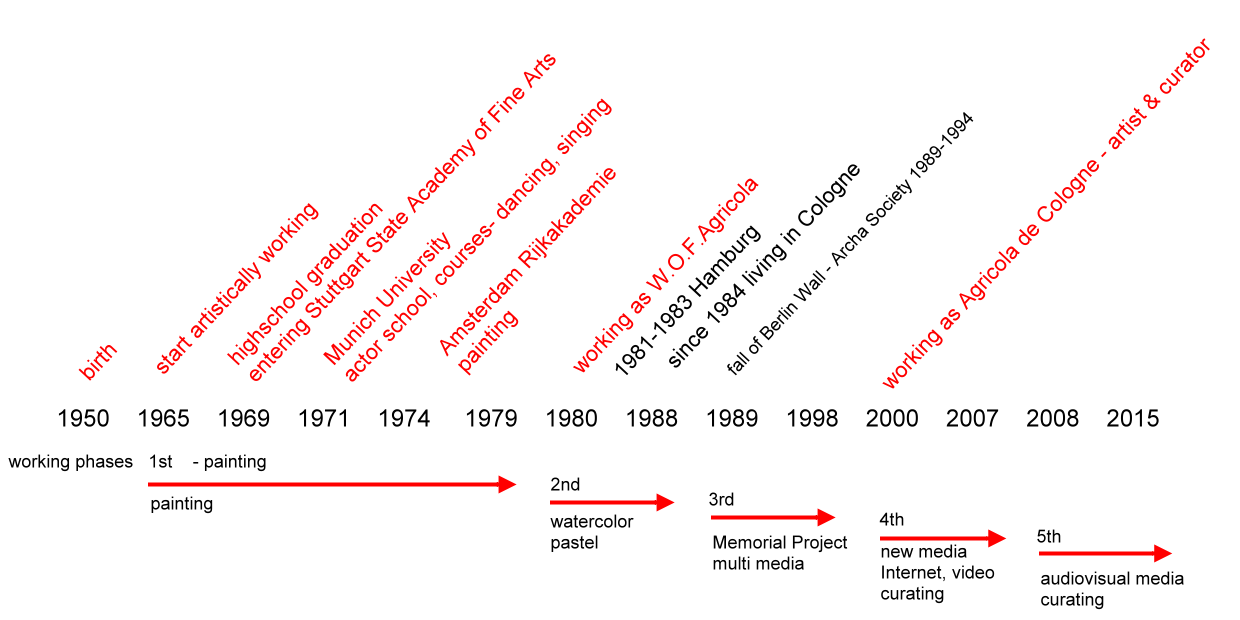


Time Line
The course of Agricola de Cologne’s life is marked by particular living phases due to moving to and living at different places on one hand, and on the other hand by different working phases, lasting always about 7-8 years, when the artist started new artistic challenges.
Fundamental influence had traumatic experiences, which were directing the artist into new directions and artistic fields: 1998 – the terror attack catapulting the artist in a months lasting coma, causing a fundamental loss of the affinity to the “material” and his re-creation as a virtual artist. The years 2008 and 2009 were not less traumaticizing, in 2008 the artist’s mother’s stroke caused a family desaster, and shortly afterwards the artist was physcially so heavily attacked in October 2008 in Caracas and a few weeks later in 2009 in Casablanca causing such traumatizations, that when He returned to Cologne, he was set into an artificial coma for many weeks in order to re-activate his self-healing powers. In 2014, the circumsstances of his mothers death were causing a final break with his family.
While the artist was encouraged from a child by his parents to deal with art, in 1965 his artistic life started when he was given a canvas and oil colors on his birthday. The first phase of artistic working lasted until he started working professional 1980, initiating the second phase lasting until 1988. It was focussed on using water colour and pastel as painting tools, which does not sound really exciting, but he developing his very personal use of thse artistic media and a very rich oeuvre transforming his philosophical ideas into a very individual visual language.
The year 1989 was marked by a re-orientation, whereby the fall of Berlin Wall directed the artist to new directions more or less by coincidence. He founded 1989 the charitable ARCHA Foundation. as its President he travelled in Eastern Europe which was forming the basis for the following Memorial Project – 1000 Years, 50 Years and still so Terribly Young” and a new type of physical art working using different 2D and 3D media in installations. 1998 this kind of art working was stopped by a terror attack which was destroying a basic part of this artistic project.
After returning to life from a many months lasting coma, the artist re-created himself on 1.January 2000 under a new name and a virtual status as – Agricola de Cologne, focussing exclusively on new media and technologies and a new type of art working in form of curating. While he was creating until 2007 a huge number of individual art projects, the 2nd phase starting in 2008 was solely dedicated to curating art & moving images, respectively audiovisual media as a festival director.
According to this obvious rhythm of phases lasting 7-8 years, the year 2015 is representing again a re-orientation.
The direction to return again to physical art work in shape of painting, 3D objects or installation is unfortunately currently no option, after the artist’s health was attacked in Februar 2017 by an heavy accident causing the partial paralization of the left bodyside.
So, the path, he is still able to follow during the coming years, is related to the project, he initiated just a few weeks before the accident, entitled: “The W:OW Project – We Are One World” – http://wow.engad.org – dealing with the Present & Future of planet EARTH under the influence of the human species – integrating previously initiated media art contexts, as well.
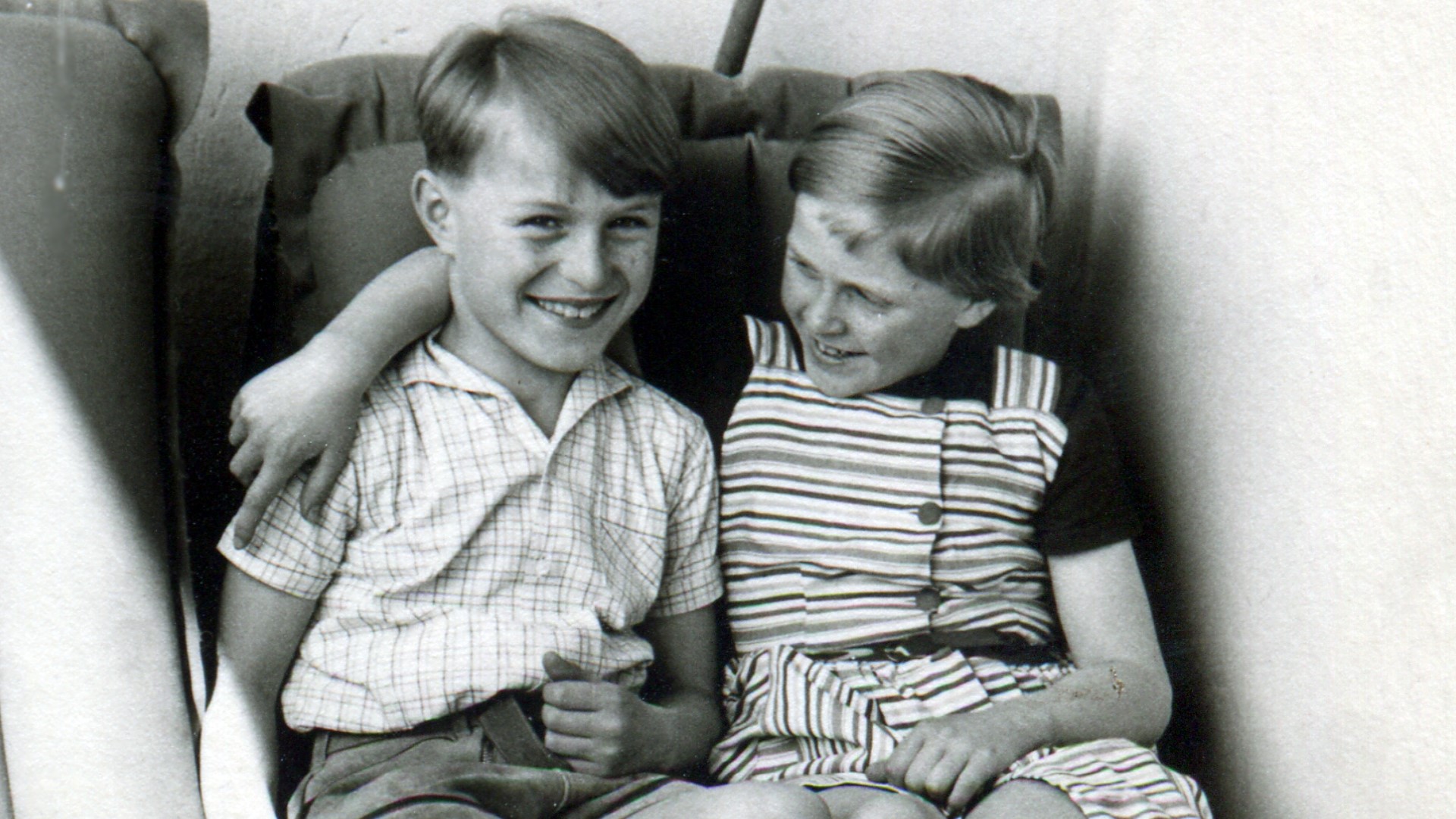


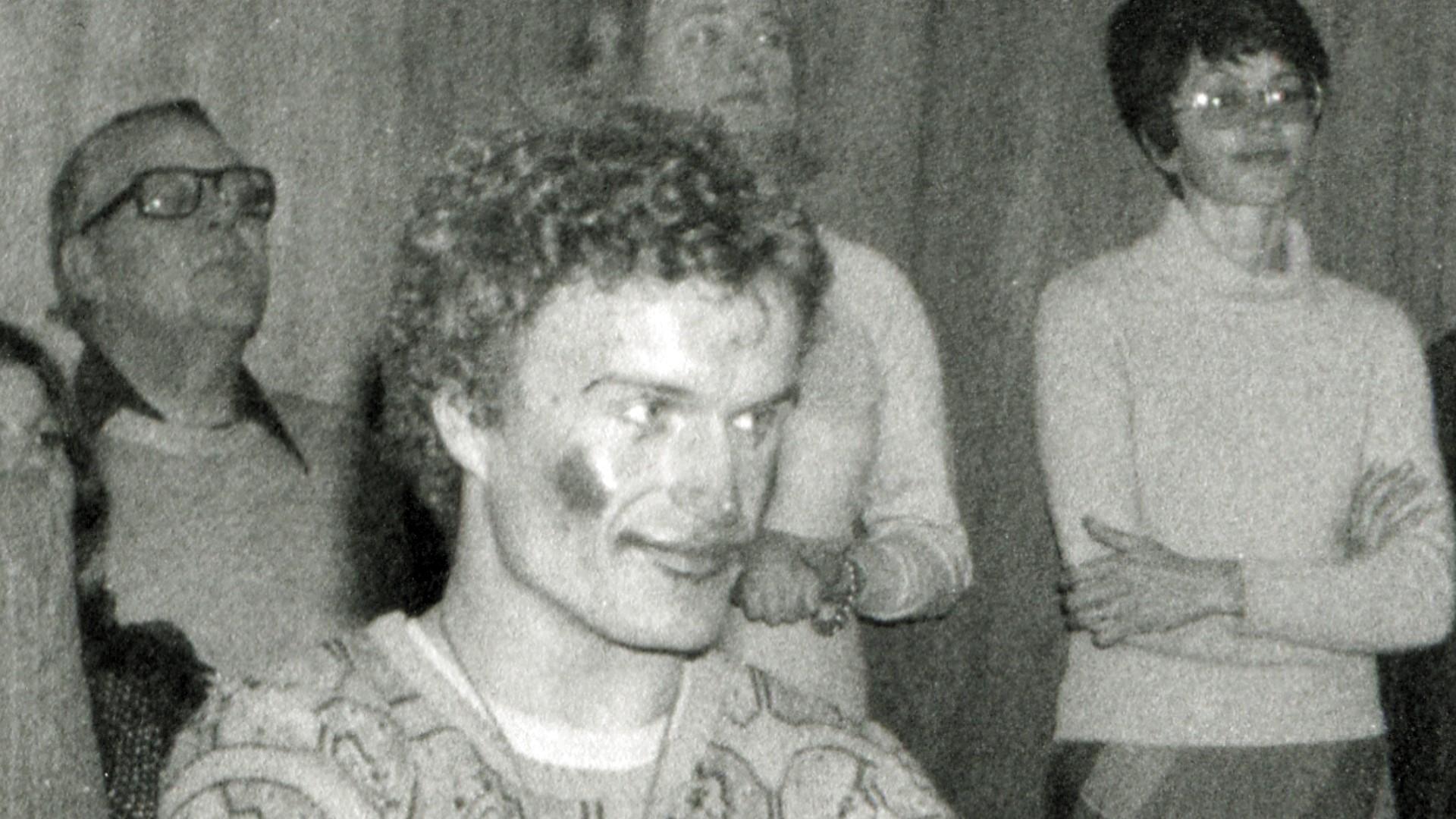



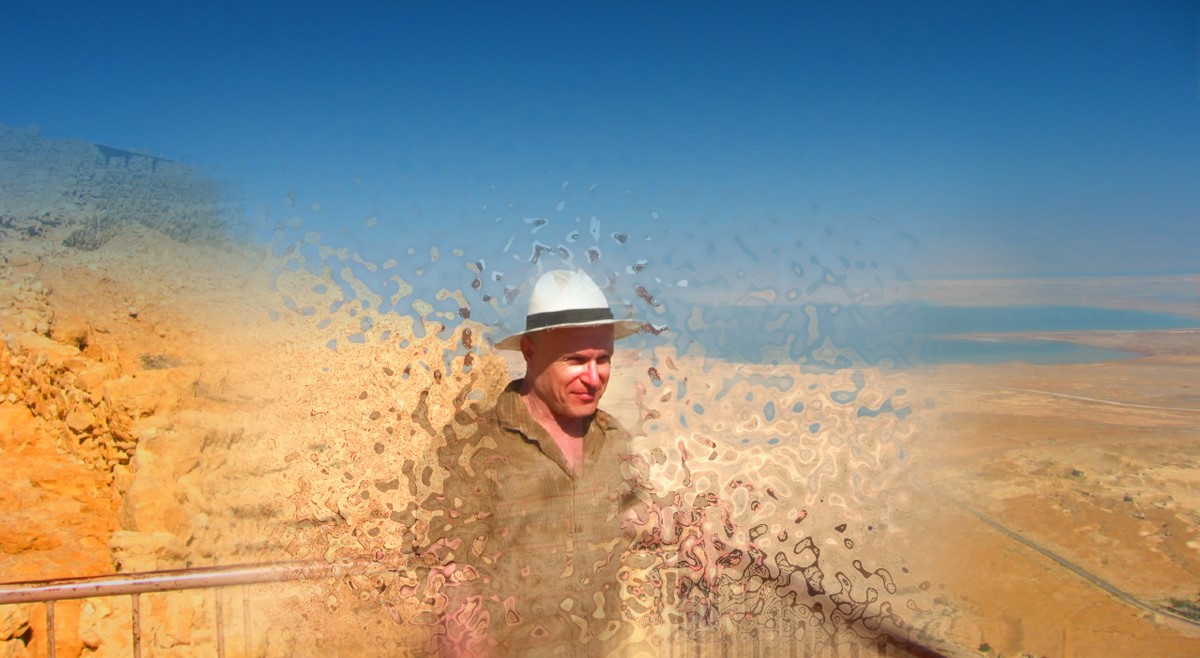
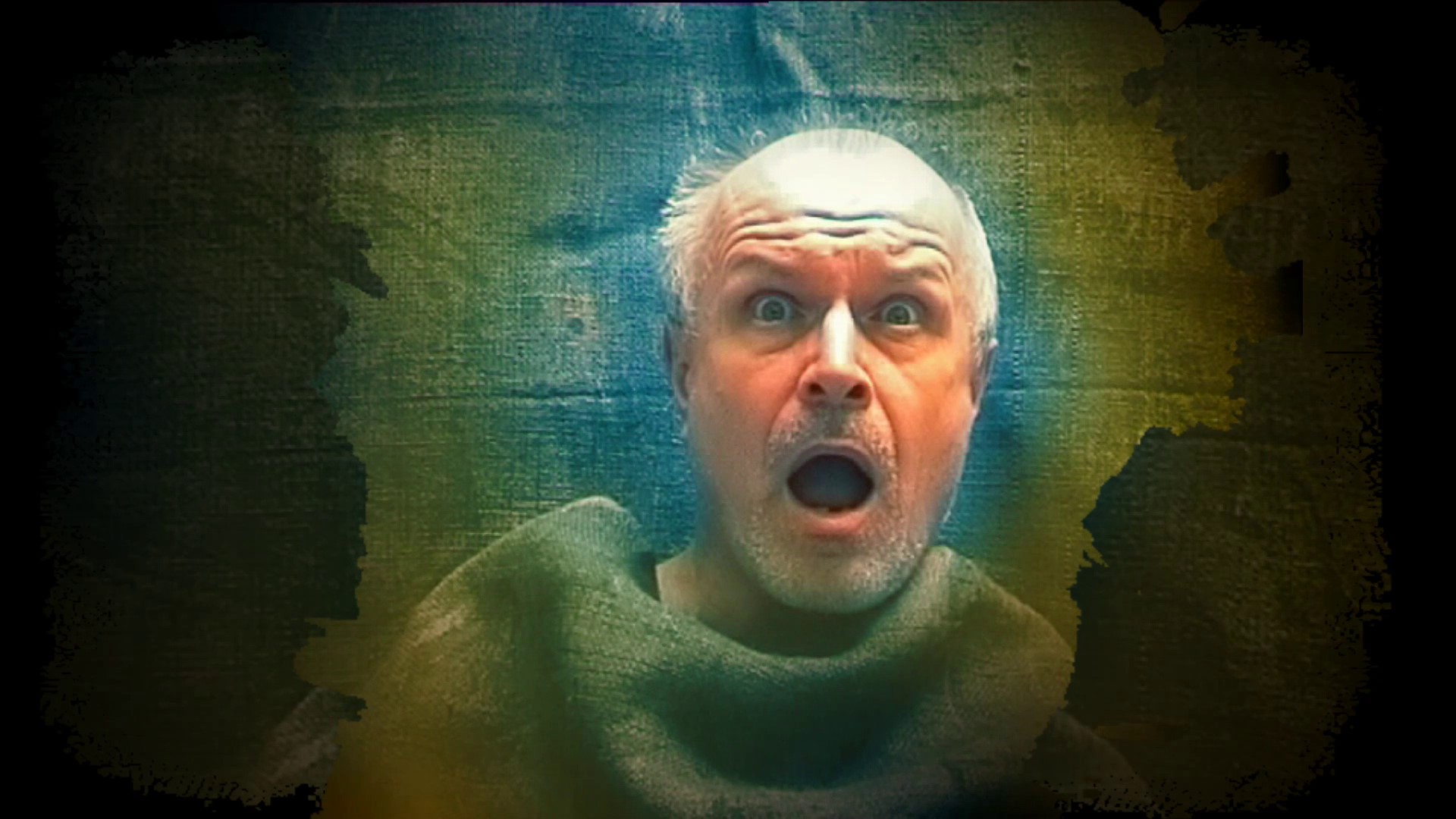
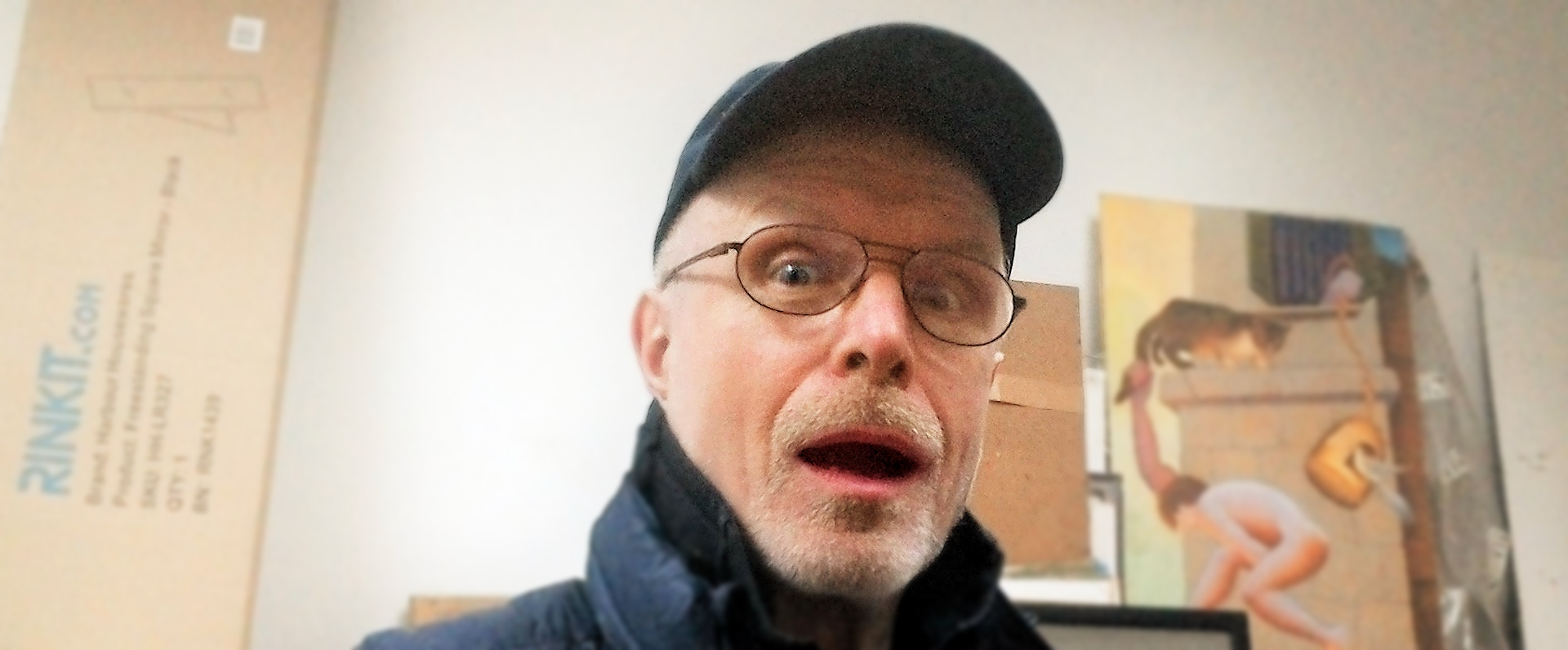
As an artist, W.O.F Agricola had two working phases – 1980-1989, the fall of the Berlin Wall is representing a fundamental break, the 2nd working phase – 1990-1998 is marked by two major projects – ARCHA Society 1990-1995, which can be considered as the starting point of curating, and the artistic Memorial, entitled: A Living Memorial Spaces of Art (1995-1998).
His artistic career was stopped and this art project destroyed by a terror attack in 1998. The artist W.OW Agricola died at the end of 1998 by falling in a several months lasting coma. The visual artist W.O.F. Agricola and his physical art work is remaining just as a shadow.
Physically born 1950 in Black Forest (Southern Germany), the artist started his carreer as an artist directly after his studies in 1980 as “W.O.F. AGRICOLA”, who died as such on 31.12.1998 as the result of a terrorist attack, to be reborn on 01.01.2000 as the brand and encoded artist “Agricola de Cologne” as the only true virtual artist and curator.
Studies
1969-1971 Stuttgart State Academy of Fine Arts (Grafic & Photography)
1971-1974 Munich University (Art History, Journalism and Dramatic Arts)
1974-1978 Rijksakademie Amsterdam (Painting)
Study sojourns
between 1985 and 2000 in Great Britain, France, Belgium, Italy, Russia, Lithuania, Latvia, Poland
residencies since 2000 in Brazil, Cuba, Latvia, Mexico
Since 1989, he realized several major collaborative and media related projects
1989-1995 Foundation of ARCHA Society- a temporary non -profit organization/cultural exchange between Western and Eastern Europe. As the President of ARCHA, Agricola organized several international conferences and cultural projects in Germany and Poland.
Since 1994 working with new technologies.
Between 1995 and 1999 realisation of the Memorial project
“A Living Memorial Spaces of Art” in 43 installations at 43 places in Germany, Poland and Czech Republic, including Krakow, Auschwitz, Terezin, Berlin, Hamburg, Cologne and others–>a complex of multi-media art works, including photography, video, computer and sound installations
1999 – physical recontruction after a many months lasting coma.
Agricola de Cologne
The artist rose from the dead, however. During a many years lasting physical reconstruction phase, he started a completely new physical and artistic life when he was launched on 1 January 2000 as Agricola de Cologne, an artist brand und virtual artist standing for the interdisciplinary media artist, creator of experimental films and videos, curator of media art, mediator, festival director, multi-media developer, programmer and designer of culture and much more. While his activities before 2003 were mainly virtual, the concepts of his activities after 2003 were focussed on the exchange between virtual & physical space.
Read more about the brand “Agricola de Cologne”
Behind Agricola de Cologne is standing a lot of biographical material, the conditions for initiating the “big bang” as an artistic action on 1 January 2000 out of itself.

For his curatorial activities he created his own operating system – artvideoKOELN international .
Since 2005, his main focus of activities was rooted on “art & moving images”. He created in 2005 CologneOFF – the International Festival Network – http://coff.newmediafest.org and was running 10 years (2005-2014) CologneOFF International Videoart Festival by realiting 10 festival editions

The New Museum of Networked Art
is representing the “divisionistic image” consisting of countless dots or a multi-dimensional sculpture in form of the individual and networking structures on different levels Agricola de Cologne created since 2000 incorporating Agricola de Cologne as a project itself. It includes also the shadow of the second life (before 2000).
In this way, Agricola de Cologne is standing also for a broad bandwidth of dynamic curatorial contexts he is initiating in physical and virtual space on the listed platforms, the co-curator and co-organiser of external festivals and exhibitions, the jury member of divers festivals, and not to forget the designer of a cross-platform culture.
networked collaborations in 120 countries since 2000
– artists network include more than 5000 artists from 80 countries
– curators network include more than 80 curators from 40 countries
– institutional network with festivals & cultural institutions including
more than 800 venues in 120 countries
References
Agricola de Cologne & his projects have been supported by
Prof. Dr. Kurt Biedenkopf
Prime Minister of Free State of Saxony (Ministerpräsident des Freistaates Sachsen)
Matthias Lechner
Mayor of the City of Goerlitz ( Oberbürgermeister der Stadt Görlitz)
International ARCHA Conference Goerlitz/Germany
1995-1999
Ignatz Bubis
President of Central Jewish Council of Germany (Präsident des Zentralrates der Juden in Deutschland)
A Living Memorial Kunsträume
Dr. Frank Michael Pietzsch,
President of Parliament of Thuringia/ Landtagspräsident Thüringen
Presentations “A Living Memorial Kunsträume” Thuringia 1996 (Präsentationen Thüringen)
W.Ch. Steinbach
President of District Council Leipzig (Regierungspräsident Leipzig)
Presentations/Präsentationen “A Living Memorial Kunsträume” Leipzig 1996
Ulrich Schmid
President of Parliament of Northrhine-Westphalia ( Landtagspräsident NRW)
Presentations/Präsentationen “A Living Memorial Kunsträume” Nordrhein-Westfalen 1998
2012-2015
European Parliament
A Virtual Memorial Riga 2012 (Latvia)
A Virtual Memorial Vilnius 2013 ()Lithuania)
A Virtual Memorial Warsaw 2013 (Poland)
A Virtual Memorial Milan 2014 (Italy)
Municipality of Milan, Province of Milan, Region of Lombardia and
Contemporary Documentation Centre for Jewish Culture Milan
A Virtual Memorial Milan 2014 (Italy)
1987
Aufbruch und Befreiung @ Simultanhalle Cologne
City of Cologne, department of culture
1991
International ARCHA Conference Goerlitz/Germany
Ministery of the Interior (Innenministerium) 1991
Ministerium für Kultur und Wissenschaft Freistaat Sachsen Dresden/Germany (1991)
City of Goerlitz, City of Zittau
1995
1000 Years, 50 Years and still so terrible young (Memorial Project) @ Municipal Archives
City of Cologne, department of culture
1998
A Living Memorial Spaces of Art (Memorial Project)
City of Cologne, department of culture
2006
Media art project [R][R][F] in Cologne
State of Northrhine-Westphalia
2008
Residency October 2008 – Maracaibo/Caracas
Ministery of Culture Caracas/Venezuela
2011
Timisoara Short Film Festival
German Cultural Institute, Goethe Institute, Ministery of the Exterior (Bundesaußenministerium)
2012
Residency May/June Riga
Culture & Arts Project NOASS
A Virtual Memorial Riga 2012 (Latvia)
Culture and Arts Project NOASS, Ministery of Culture Riga, US Embassy in Riga, Swedish Embassy in Riga, Austrian Embassy in Riga
Embassy of Israel in Riga, State of Israel Ministry of Foreign Affairs
2013
A Virtual Memorial Vilnius 2013 (Lithuania)
Lithuanian Jewish Community, Lithuanian Film Center, Vilnius Municipality
Italian Culture Institute Vilnius, Institut Français Vilnius
Austrian Embassy Vilnius, Swedish Embassy Vilnius, US Embassy Vilnius, UK Embassy Vilnius,
Israeli Embassy Riga, State of Israel Ministry of Foreign Affairs
A Virtual Memorial Warsaw 2013
Germany Embassy Warsaw
2014
A Virtual Memorial Timisoara 2014 (Italy)
German Cultural Institute Timisoara/ro
Goethe Institut Sofia/Bulgaria (2003)
Goethe Institut Bratislava/Slovakia (2003)
Goethe Institut Bangkok/thailand (2004)
Goethe Institut Sao Paulo/Brazil (2005)
Goethe Institut Montevideo/Uruguay (2005)
Goethe Institut Hongkong (2009)
Goethe Institut Rabat/Morocco (2009)
Goethe Institut Ukraine Kiev (2011)
Goethe Institut St.Petersburg/Russia (2011)
Goethe Institut Munich/Headquaters (2011)
Goethe Institut Bangkok/Thailand (2012)
Goethe Institut Novosibirsk/Russia (2012)

